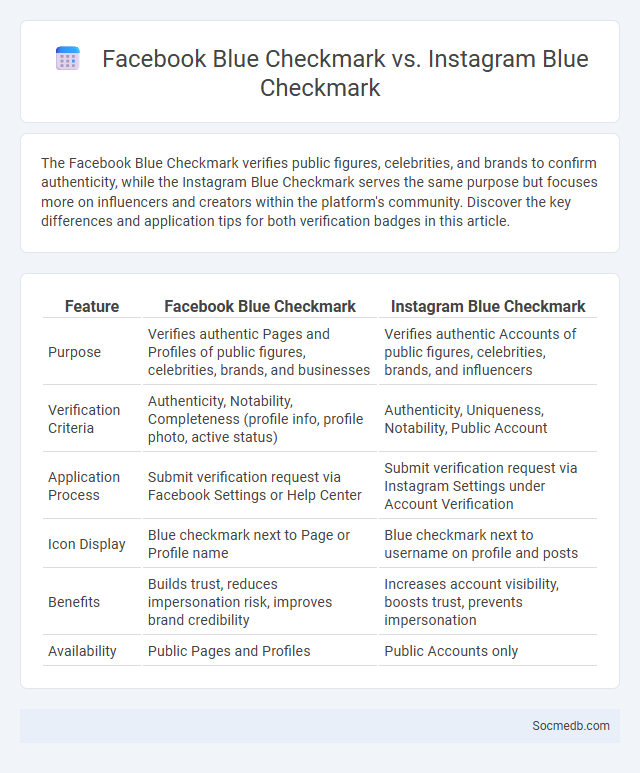
Photo illustration: Facebook Blue Checkmark vs Instagram Blue Checkmark
The Facebook Blue Checkmark verifies public figures, celebrities, and brands to confirm authenticity, while the Instagram Blue Checkmark serves the same purpose but focuses more on influencers and creators within the platform's community. Discover the key differences and application tips for both verification badges in this article.
Table of Comparison
| Feature | Facebook Blue Checkmark | Instagram Blue Checkmark |
|---|---|---|
| Purpose | Verifies authentic Pages and Profiles of public figures, celebrities, brands, and businesses | Verifies authentic Accounts of public figures, celebrities, brands, and influencers |
| Verification Criteria | Authenticity, Notability, Completeness (profile info, profile photo, active status) | Authenticity, Uniqueness, Notability, Public Account |
| Application Process | Submit verification request via Facebook Settings or Help Center | Submit verification request via Instagram Settings under Account Verification |
| Icon Display | Blue checkmark next to Page or Profile name | Blue checkmark next to username on profile and posts |
| Benefits | Builds trust, reduces impersonation risk, improves brand credibility | Increases account visibility, boosts trust, prevents impersonation |
| Availability | Public Pages and Profiles | Public Accounts only |
Overview: What Is the Blue Checkmark?
The blue checkmark on social media platforms like Twitter, Instagram, and Facebook signifies a verified account, confirming the authenticity of public figures, celebrities, brands, and organizations. This verification badge helps users distinguish genuine accounts from impersonators or fake profiles, enhancing trust and credibility. Social media verification processes vary but typically require submission of official identification and adherence to platform-specific criteria.
Facebook Blue Checkmark: Features and Purpose
The Facebook Blue Checkmark signifies verified accounts, providing authenticity for public figures, brands, and businesses. This verification helps users distinguish genuine profiles from impersonators, enhancing trust and credibility across the platform. Key features include increased visibility in search results and access to special account tools for content management and security.
Instagram Blue Checkmark: Features and Significance
The Instagram Blue Checkmark signifies verified accounts belonging to public figures, brands, or entities, providing authenticity and helping users distinguish genuine profiles from impersonators. This verification badge enhances credibility, increases visibility in search results, and often leads to higher engagement rates on posts and stories. Features include account authenticity confirmation, access to exclusive tools, and priority handling in account support.
Eligibility Criteria for Facebook Blue Check
To be eligible for the Facebook Blue Check, accounts must represent public figures, celebrities, global brands, or notable entities with a significant following or media presence. Verification requires the account to be complete with a profile picture, cover photo, and active status, reflecting authenticity and public interest. Facebook prioritizes eligibility for pages and profiles that demonstrate a high likelihood of being impersonated or are widely recognized in their field or community.
Eligibility Criteria for Instagram Blue Check
Instagram Blue Check eligibility requires accounts to be authentic, notable, and active. Eligible profiles must represent a real person, registered business, or entity, and demonstrate uniqueness with only one account per person or business allowed. Verification is granted primarily to public figures, celebrities, brands, or entities with a high likelihood of impersonation, and accounts must comply with Instagram's terms of service and community guidelines.
Verification Process: Facebook vs Instagram
The verification process on Facebook requires submitting a government-issued ID and proof of authenticity, focusing on public figures, brands, and entities to prevent impersonation. Instagram's verification emphasizes account completeness, adherence to community guidelines, and a unique presence, requesting identification to confirm legitimacy. Both platforms aim to enhance trust and authenticity, but Instagram streamlines approvals for influencers and creators, while Facebook prioritizes established organizations and public officials.
Costs and Subscription: Meta Verified Program
The Meta Verified Program offers users enhanced account security and increased visibility on social media platforms for a monthly subscription fee, which varies by region but typically ranges from $11.99 to $19.99. This cost covers benefits such as real-time account monitoring, direct access to customer support, and a verification badge that boosts credibility. By subscribing, you can improve your social media presence while managing expenses through a transparent, tiered pricing structure.
Benefits of Having a Blue Checkmark
A blue checkmark on social media platforms like Twitter and Instagram serves as a verified badge, confirming the authenticity of your account and enhancing your online credibility. This verification boosts your visibility, helping you reach a larger audience and increasing engagement on your posts. Having a blue checkmark also protects your brand from impersonation, ensuring your followers trust the source of your content.
Common Misconceptions about Blue Checkmarks
Many users mistakenly believe that blue checkmarks on social media platforms exclusively signify verified celebrity status or popularity, when in reality, they indicate account authenticity and credibility. You should understand that platforms use blue checkmarks to protect public figures, brands, and organizations from impersonation, not to endorse content or guarantee quality. Misinterpreting this symbol can lead to misguided trust and misinformation in your online interactions.
Which Blue Checkmark Is Right for You?
Choosing the right blue checkmark on social media depends on your account type and verification goals. Platforms like Twitter, Instagram, and Facebook offer badges for individuals, businesses, and public figures, each with distinct verification criteria. Understanding the differences between personal badges, branded checkmarks, and organizational certifications helps enhance credibility and ensures appropriate audience trust.
 socmedb.com
socmedb.com